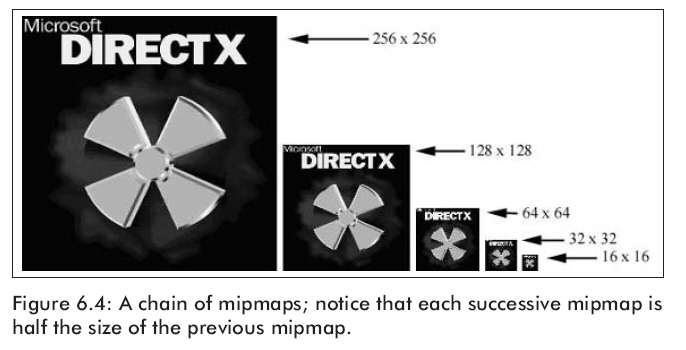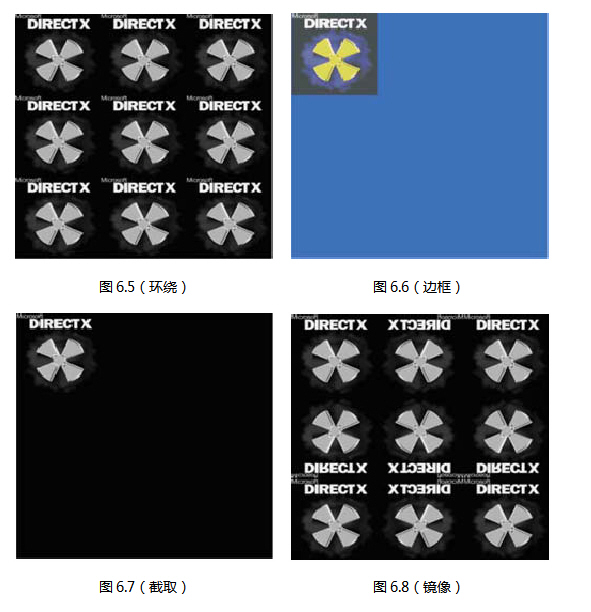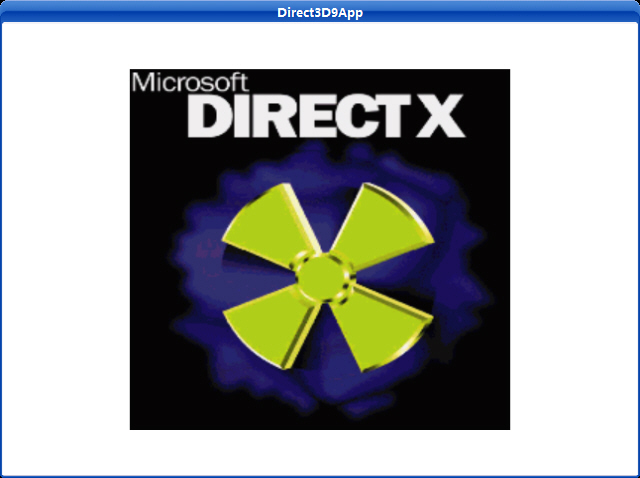就象6.3节所说的,在屏幕上的三角形和纹理三角形通常是不一样大的。为了使这个大小差异变小,我们为纹理创建mipmaps链。也就是说将一个纹理创建成连续的变小的纹理,但是对它们等级进行定制过滤,因此对我们来说保存细节是很重要的(如图6.4)。

6.4.1 Mipmaps过滤器
mipmap过滤器是被用来控制Direct3D使用mipmaps的。设置mipmap过滤器,你可以这样写:
|
Device->SetSamplerState(0,
D3DSAMP_MIPFILTER, Filter);
|
在Filter处你能用下面三个选项中的一个:
D3DTEXF_NONE——不使用mipmap。
D3DTEXF_POINT——通过使用这个过滤器,Direct3D将选择与屏幕三角形大小最接近的mipmap等级。一旦等级选定了,Direct3D就将按照指定的过滤器进行缩小和放大过滤。
D3DTEXF_LINEAR——通过使用这个过滤器,Direct3D将选择两个最接近的mipmap等级,缩小和放大过滤每个等级,然后线性联合计算它们两个等级来得到最终的颜色值。
以前,我们规定纹理坐标必须指定在[0,1]之间。从技术上来说这是不正确的;他们能够超出这个范围。纹理坐标也可以在[0,1]的范围之外,它通过Direct3D的寻址模式来定义。这里有四种寻址模式:环绕纹理寻址模式、边框颜色纹理寻址模式、截取纹理寻址模式、镜像纹理寻址模式,这里分别给出了它们的示意图6.5,6.6,6.7,6.8。

在这些图片中,纹理坐标通过(0,0)(0,3)(3,0)(3,3)顶点来定义。在u轴和v轴上方块又被分成子块放进3×3的矩阵中。假如,你想让纹理按5×5的方格来平铺,你就应该指定环绕纹理寻址模式并且纹理坐标应该设置为(0,0)(0,5)(5,0)(5,5)。
Sampler states define texture sampling operations such
as texture addressing and texture filtering. Some sampler states set-up vertex
processing, and some set-up pixel processing. Sampler states can be saved and
restored using stateblocks (see State Blocks Save and Restore State (Direct3D
9)).
typedef enum D3DSAMPLERSTATETYPE
{
D3DSAMP_ADDRESSU = 1,
D3DSAMP_ADDRESSV = 2,
D3DSAMP_ADDRESSW = 3,
D3DSAMP_BORDERCOLOR = 4,
D3DSAMP_MAGFILTER = 5,
D3DSAMP_MINFILTER = 6,
D3DSAMP_MIPFILTER = 7,
D3DSAMP_MIPMAPLODBIAS = 8,
D3DSAMP_MAXMIPLEVEL = 9,
D3DSAMP_MAXANISOTROPY = 10,
D3DSAMP_SRGBTEXTURE = 11,
D3DSAMP_ELEMENTINDEX = 12,
D3DSAMP_DMAPOFFSET = 13,
D3DSAMP_FORCE_DWORD = 0x7fffffff,
} D3DSAMPLERSTATETYPE, *LPD3DSAMPLERSTATETYPE;
Constants
- D3DSAMP_ADDRESSU
- Texture-address mode for the u coordinate. The
default is D3DTADDRESS_WRAP. For more information, see D3DTEXTUREADDRESS.
- D3DSAMP_ADDRESSV
- Texture-address mode for the v coordinate. The
default is D3DTADDRESS_WRAP. For more information, see D3DTEXTUREADDRESS.
- D3DSAMP_ADDRESSW
- Texture-address mode for the w coordinate. The
default is D3DTADDRESS_WRAP. For more information, see D3DTEXTUREADDRESS.
- D3DSAMP_BORDERCOLOR
- Border color or type D3DCOLOR. The default color
is 0x00000000.
- D3DSAMP_MAGFILTER
- Magnification filter of type D3DTEXTUREFILTERTYPE.
The default value is D3DTEXF_POINT.
- D3DSAMP_MINFILTER
- Minification filter of type
D3DTEXTUREFILTERTYPE. The default value is D3DTEXF_POINT.
- D3DSAMP_MIPFILTER
- Mipmap filter to use during minification. See
D3DTEXTUREFILTERTYPE. The default value is D3DTEXF_NONE.
- D3DSAMP_MIPMAPLODBIAS
- Mipmap level-of-detail bias. The default value is
zero.
- D3DSAMP_MAXMIPLEVEL
- level-of-detail index of largest map to use.
Values range from 0 to (n - 1) where 0 is the largest. The default value is
zero.
- D3DSAMP_MAXANISOTROPY
- DWORD maximum anisotropy. The default value is 1.
- D3DSAMP_SRGBTEXTURE
- Gamma correction value. The default value is 0,
which means gamma is 1.0 and no correction is required. Otherwise, this
value means that the sampler should assume gamma of 2.2 on the content and
convert it to linear (gamma 1.0) before presenting it to the pixel shader.
- D3DSAMP_ELEMENTINDEX
- When a multielement texture is assigned to the
sampler, this indicates which element index to use. The default value is 0.
- D3DSAMP_DMAPOFFSET
- Vertex offset in the presampled displacement map.
This is a constant used by the tessellator, its default value is 0.
- D3DSAMP_FORCE_DWORD
- Forces this enumeration to compile to 32 bits in
size. Without this value, some compilers would allow this enumeration to
compile to a size other than 32 bits. This value is not used.
下面的代码片段列举的是怎样设置这四种寻址模式:
// set wrap address mode
if( ::GetAsyncKeyState('W') & 0x8000f )
{
Device->SetSamplerState(0, D3DSAMP_ADDRESSU, D3DTADDRESS_WRAP);
Device->SetSamplerState(0, D3DSAMP_ADDRESSV, D3DTADDRESS_WRAP);
}
// set border color address mode
if( ::GetAsyncKeyState('B') & 0x8000f )
{
Device->SetSamplerState(0, D3DSAMP_ADDRESSU, D3DTADDRESS_BORDER);
Device->SetSamplerState(0, D3DSAMP_ADDRESSV, D3DTADDRESS_BORDER);
Device->SetSamplerState(0, D3DSAMP_BORDERCOLOR, 0x000000ff);
}
// set clamp address mode
if( ::GetAsyncKeyState('C') & 0x8000f )
{
Device->SetSamplerState(0, D3DSAMP_ADDRESSU, D3DTADDRESS_CLAMP);
Device->SetSamplerState(0, D3DSAMP_ADDRESSV, D3DTADDRESS_CLAMP);
}
// set mirror address mode
if( ::GetAsyncKeyState('M') & 0x8000f )
{
Device->SetSamplerState(0, D3DSAMP_ADDRESSU, D3DTADDRESS_MIRROR);
Device->SetSamplerState(0, D3DSAMP_ADDRESSV, D3DTADDRESS_MIRROR);
}
6.6实例程序:有纹理的方块
这个例子演示怎样为方块加上纹理以及设置一个纹理过滤器(如图6.9)。假如你的显卡支持,通过D3DXCreateTextureFromFile函数一个mipmap链将被自动创建。

图6.9
为一个场景增加纹理的必要步骤是:
1. 构造物体的顶点并指定纹理坐标。
2. 用D3DXCreateTextureFromFile函数读取一个纹理到IDirect3DTexture9接口中。
3. 设置缩小倍数,放大倍数以及mipmap过滤器。
4. 在你绘制一个物体前,用IDirect3DDevice9::SetTexture设置与物体关联的纹理。
源程序:
/**************************************************************************************
Renders a textured quad. Demonstrates creating a texture, setting texture filters,
enabling a texture, and texture coordinates.
**************************************************************************************/
#include "d3dUtility.h"
#pragma warning(disable : 4100)
const int WIDTH = 640;
const int HEIGHT = 480;
IDirect3DDevice9* g_d3d_device;
IDirect3DVertexBuffer9* g_quad_vb;
IDirect3DTexture9* g_d3d_texture;
class cTextureVertex
{
public:
float m_x, m_y, m_z;
float m_nx, m_ny, m_nz;
float m_u, m_v; // texture coordinates
cTextureVertex() { }
cTextureVertex(float x, float y, float z,
float nx, float ny, float nz,
float u, float v)
{
m_x = x; m_y = y; m_z = z;
m_nx = nx; m_ny = ny; m_nz = nz;
m_u = u; m_v = v;
}
};
const DWORD TEXTURE_VERTEX_FVF = D3DFVF_XYZ | D3DFVF_NORMAL | D3DFVF_TEX1;
////////////////////////////////////////////////////////////////////////////////////////////////////
bool setup()
{
// create the quad vertex buffer and fill it with the quad geometry
g_d3d_device->CreateVertexBuffer(6 * sizeof(cTextureVertex), D3DUSAGE_WRITEONLY, TEXTURE_VERTEX_FVF,
D3DPOOL_MANAGED, &g_quad_vb, NULL);
cTextureVertex* vertices;
g_quad_vb->Lock(0, 0, (void**)&vertices, 0);
// quad built from two triangles, note texture coordinate.
vertices[0] = cTextureVertex(-1.0f, -1.0f, 1.25f, 0.0f, 0.0f, -1.0f, 0.0f, 1.0f);
vertices[1] = cTextureVertex(-1.0f, 1.0f, 1.25f, 0.0f, 0.0f, -1.0f, 0.0f, 0.0f);
vertices[2] = cTextureVertex( 1.0f, 1.0f, 1.25f, 0.0f, 0.0f, -1.0f, 1.0f, 0.0f);
vertices[3] = cTextureVertex(-1.0f, -1.0f, 1.25f, 0.0f, 0.0f, -1.0f, 0.0f, 1.0f);
vertices[4] = cTextureVertex( 1.0f, 1.0f, 1.25f, 0.0f, 0.0f, -1.0f, 1.0f, 0.0f);
vertices[5] = cTextureVertex( 1.0f, -1.0f, 1.25f, 0.0f, 0.0f, -1.0f, 1.0f, 1.0f);
g_quad_vb->Unlock();
// create the texture and set filters
D3DXCreateTextureFromFile(g_d3d_device, "dx5_logo.bmp", &g_d3d_texture);
g_d3d_device->SetTexture(0, g_d3d_texture);
g_d3d_device->SetSamplerState(0, D3DSAMP_MAGFILTER, D3DTEXF_LINEAR);
g_d3d_device->SetSamplerState(0, D3DSAMP_MINFILTER, D3DTEXF_LINEAR);
g_d3d_device->SetSamplerState(0, D3DSAMP_MIPFILTER, D3DTEXF_POINT);
// don't use lighting for this sample
g_d3d_device->SetRenderState(D3DRS_LIGHTING, FALSE);
// set the projection matrix
D3DXMATRIX proj;
D3DXMatrixPerspectiveFovLH(&proj, D3DX_PI * 0.5f, (float)WIDTH/HEIGHT, 1.0f, 1000.0f);
g_d3d_device->SetTransform(D3DTS_PROJECTION, &proj);
return true;
}
void cleanup()
{
safe_release<IDirect3DVertexBuffer9*>(g_quad_vb);
safe_release<IDirect3DTexture9*>(g_d3d_texture);
}
bool display(float time_delta)
{
g_d3d_device->Clear(0, NULL, D3DCLEAR_TARGET | D3DCLEAR_ZBUFFER, 0xffffffff, 1.0f, 0);
g_d3d_device->BeginScene();
g_d3d_device->SetStreamSource(0, g_quad_vb, 0, sizeof(cTextureVertex));
g_d3d_device->SetFVF(TEXTURE_VERTEX_FVF);
g_d3d_device->DrawPrimitive(D3DPT_TRIANGLELIST, 0, 2);
g_d3d_device->EndScene();
g_d3d_device->Present(NULL, NULL, NULL, NULL);
return true;
}
LRESULT CALLBACK wnd_proc(HWND hwnd, UINT msg, WPARAM word_param, LPARAM long_param)
{
switch(msg)
{
case WM_DESTROY:
PostQuitMessage(0);
break;
case WM_KEYDOWN:
if(word_param == VK_ESCAPE)
DestroyWindow(hwnd);
break;
}
return DefWindowProc(hwnd, msg, word_param, long_param);
}
int WINAPI WinMain(HINSTANCE inst, HINSTANCE, PSTR cmd_line, int cmd_show)
{
if(! init_d3d(inst, WIDTH, HEIGHT, true, D3DDEVTYPE_HAL, &g_d3d_device))
{
MessageBox(NULL, "init_d3d() - failed.", 0, MB_OK);
return 0;
}
if(! setup())
{
MessageBox(NULL, "Steup() - failed.", 0, MB_OK);
return 0;
}
enter_msg_loop(display);
cleanup();
g_d3d_device->Release();
return 0;
}
setup程序是很容易读懂的;我们用已经定义了纹理坐标的两个三角形创建一个方块。然后把文件dx5_logo.bmp读进IDirect3DTexture9接口中。接着使用SetTexture方法赋予纹理,最后设置缩小和放大过滤器进行线性过滤,我们也可以设置mipmap过滤器来进行D3DTEXF_POINT。
下载源程序